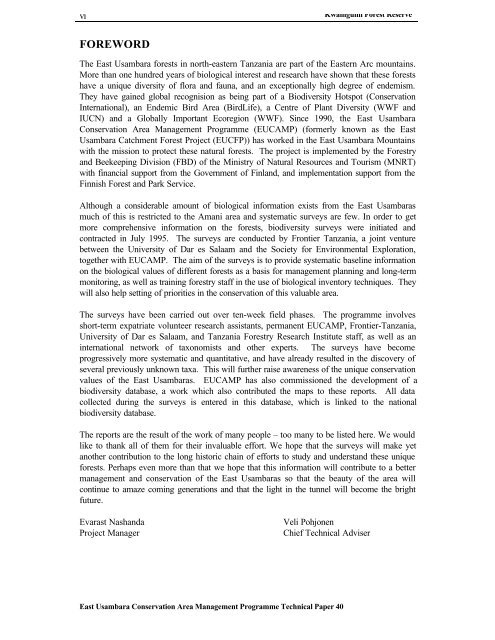Kwamgumi Forest Reserve - Frontier-publications.co.uk
Kwamgumi Forest Reserve - Frontier-publications.co.uk
Kwamgumi Forest Reserve - Frontier-publications.co.uk
Create successful ePaper yourself
Turn your PDF publications into a flip-book with our unique Google optimized e-Paper software.
vi<br />
<strong>Kwamgumi</strong> <strong>Forest</strong> <strong>Reserve</strong><br />
FOREWORD<br />
The East Usambara forests in north-eastern Tanzania are part of the Eastern Arc mountains.<br />
More than one hundred years of biological interest and research have shown that these forests<br />
have a unique diversity of flora and fauna, and an exceptionally high degree of endemism.<br />
They have gained global re<strong>co</strong>gnision as being part of a Biodiversity Hotspot (Conservation<br />
International), an Endemic Bird Area (BirdLife), a Centre of Plant Diversity (WWF and<br />
IUCN) and a Globally Important E<strong>co</strong>region (WWF). Since 1990, the East Usambara<br />
Conservation Area Management Programme (EUCAMP) (formerly known as the East<br />
Usambara Catchment <strong>Forest</strong> Project (EUCFP)) has worked in the East Usambara Mountains<br />
with the mission to protect these natural forests. The project is implemented by the <strong>Forest</strong>ry<br />
and Beekeeping Division (FBD) of the Ministry of Natural Resources and Tourism (MNRT)<br />
with financial support from the Government of Finland, and implementation support from the<br />
Finnish <strong>Forest</strong> and Park Service.<br />
Although a <strong>co</strong>nsiderable amount of biological information exists from the East Usambaras<br />
much of this is restricted to the Amani area and systematic surveys are few. In order to get<br />
more <strong>co</strong>mprehensive information on the forests, biodiversity surveys were initiated and<br />
<strong>co</strong>ntracted in July 1995. The surveys are <strong>co</strong>nducted by <strong>Frontier</strong> Tanzania, a joint venture<br />
between the University of Dar es Salaam and the Society for Environmental Exploration,<br />
together with EUCAMP. The aim of the surveys is to provide systematic baseline information<br />
on the biological values of different forests as a basis for management planning and long-term<br />
monitoring, as well as training forestry staff in the use of biological inventory techniques. They<br />
will also help setting of priorities in the <strong>co</strong>nservation of this valuable area.<br />
The surveys have been carried out over ten-week field phases. The programme involves<br />
short-term expatriate volunteer research assistants, permanent EUCAMP, <strong>Frontier</strong>-Tanzania,<br />
University of Dar es Salaam, and Tanzania <strong>Forest</strong>ry Research Institute staff, as well as an<br />
international network of taxonomists and other experts. The surveys have be<strong>co</strong>me<br />
progressively more systematic and quantitative, and have already resulted in the dis<strong>co</strong>very of<br />
several previously unknown taxa. This will further raise awareness of the unique <strong>co</strong>nservation<br />
values of the East Usambaras. EUCAMP has also <strong>co</strong>mmissioned the development of a<br />
biodiversity database, a work which also <strong>co</strong>ntributed the maps to these reports. All data<br />
<strong>co</strong>llected during the surveys is entered in this database, which is linked to the national<br />
biodiversity database.<br />
The reports are the result of the work of many people – too many to be listed here. We would<br />
like to thank all of them for their invaluable effort. We hope that the surveys will make yet<br />
another <strong>co</strong>ntribution to the long historic chain of efforts to study and understand these unique<br />
forests. Perhaps even more than that we hope that this information will <strong>co</strong>ntribute to a better<br />
management and <strong>co</strong>nservation of the East Usambaras so that the beauty of the area will<br />
<strong>co</strong>ntinue to amaze <strong>co</strong>ming generations and that the light in the tunnel will be<strong>co</strong>me the bright<br />
future.<br />
Evarast Nashanda<br />
Project Manager<br />
Veli Pohjonen<br />
Chief Technical Adviser<br />
East Usambara Conservation Area Management Programme Technical Paper 40
















